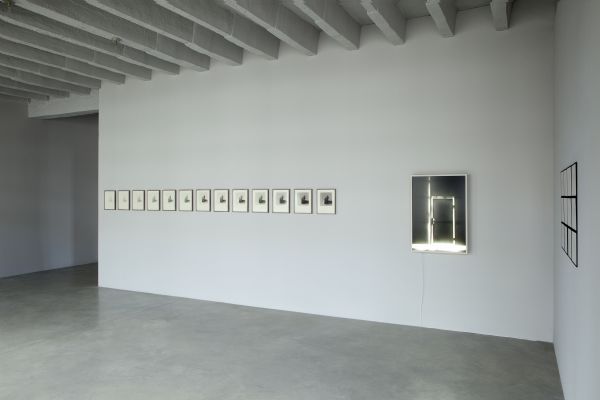-
›
- deutsch

perceptions, 2016, Galerie Grundemark Nilsson, Berlin
»From my earliest childhood I have loved stones. […] Also, I like the sound of the word ishi [stone]. When I pronounce the word, it is like spitting out the sound and I feel all over the strength of the stone. I think the word ishi [stone] implies ishi [will]. Like Daruma turning to stone after facing the wall in meditation, stone endures.«
Toru Takemitsu, Confronting Silence, p. 22
The 13 photographs of the same image of a stone reveal a sequential and incremental evolution: from wafting weightless, soft tones, the outlines and contours of the rock gradually extract themselves from the paper by means of nuanced gradations of gray, becoming all the more present in their compactness with each step, only to retreat just as quickly back into the darkness of the shadow.
When viewed gradually, the progression of the indolent scrutinization enables an amplifying mesmerization: the increasing enthrallment for the detail that invariably demands registration – not in one quick go, but rather in a languid process of "beholding".
With each stage of the emergence, the materiality of the subject evolves; with each emergence, something also synchronously steps into the background: the dissolution is superseded by the liberation of a presence and nature of the object. This "is" and "is not" leaves an aspect concealed, but with a concomitant awareness and presence of that which is concealed. This synchronicity of intensification/dissolution is inherently something enduring, something constantly nascent, and thereby maintains a temporary form of stability.
The linearity of the sequence also experiences, due to the gradual change in tonalities, a gradual transformation in the spatial perception: a shift between object and sign, from foreground and background, from perspective and perception. The superposition/exuviation of the layers of tonality and density permit the view into the depths and heights, between lightness and weightiness.
The repetition of the subject causes the previous image to appear anew in the next as memory. Like a reverberation or vestige that carries the gaze into the next picture, the one also includes the other but is nevertheless different. This repetition also connotes the handling and use, the "action" of and taken with the (photographic) object. It is like a slowly attained skill; comparable to when one uses a specific knife everyday and its handle gets more and more familiar in the hand, as does its manipulation and certainty of cut.
While underway the gaze oscillates between absence and presence and, in doing so, perceives the differentiated vibrations of materiality. The tonal tintinnabulation differs within each picture. One has the desire to stroke over them so as to perceive the scratching and fine scraping of the calcareous, pitted structure of the stone, which bristles like dry skin but nevertheless wants to be enfolded, seized and coveted, felt and explored, by the eyes and ears of the viewer. Here, the eye and the ear converge: in a continual process of escalation and de-escalation of tone and tonality that has the appearance of being embedded in a never-ending basal humming.
Within the movement between the poles of light and dark, the suspension of contrast can be achieved. If the means of rapprochement is likewise travelled, the integrity of a translation is possible.
Translation: Bryin Abraham